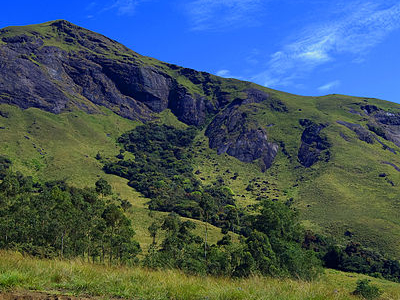Spread over a 97 square kilometer highly protected area, the Eravikulam National Park is located along the Western Ghats in the Idukki District of Kerala. These Western Ghats, the Anamalai Sub-Cluster, and including all of the Eravikulam National Park are under consideration for selection as a World Heritage Site by the UNESCO World Heritage Committee.
A high rolling hill plateau with a base elevation of 2000 meters, the main terrain of this park consists of high altitude grasslands interspersed with shoals. Anamudi, with a height of 2695 meters is the highest peak in India, below the Himalayan belt, and snugly located right within the Eravikulam National Park. Many seasonal streams criss-cross the park and merge together as tributaries of the Periyar and Chalakudiyar Rivers which finally flow east into the Cauvery River in Tamilnadu.
Twenty-Six species of mammals have been recorded within the Eravikulam national Park, which along with the Nilgiri Tahr include Gaur, the Indian Muntjac, the Sambar Deer, Golden Jackal, Jungle Cat, Wild Dog, Dhole, Leopard and the Tiger. Little known animals like the Nilgiri Langur, Stripe Necked Mongoose, the Indian Porcupine, Nilgiri Marten, Small Clawed Otter, Ruddy Mongoose and Elephants register their seasonal presence from time to time. Nineteen species of amphibians and over 132 species of birds that include the Black and Orange Flycatcher, Nilgiri Pipit, Nilgiri Wood Pigeon and the Kerala Laughing-Thrush have been recorded to be dwelling within the Eravikulam National Park.
This park is approachable from Kochi and Coimbatore Airports which are almost equidistant from opposing sides. Munnar however, is the closest town situated 13 kilometers from the National Park.
Nilgiri Tahr – These are stocky goats with short coarse fur, and bristly mane and which are endemic to the Nilgiri Hills and the southern portion of the Western Ghats falling within the states of Tamilnadu & Kerala. Males are usually larger (weighing about 80-100 kilograms) than the females and develop a darker color as they mature. These Tahrs inhabit the open montane grassland habitat of the southern Western Ghats, the upper regions of the rain forest eco-region. These undulates are well protected in the Eravikulam National Park and currently numbering 750 as per records.

